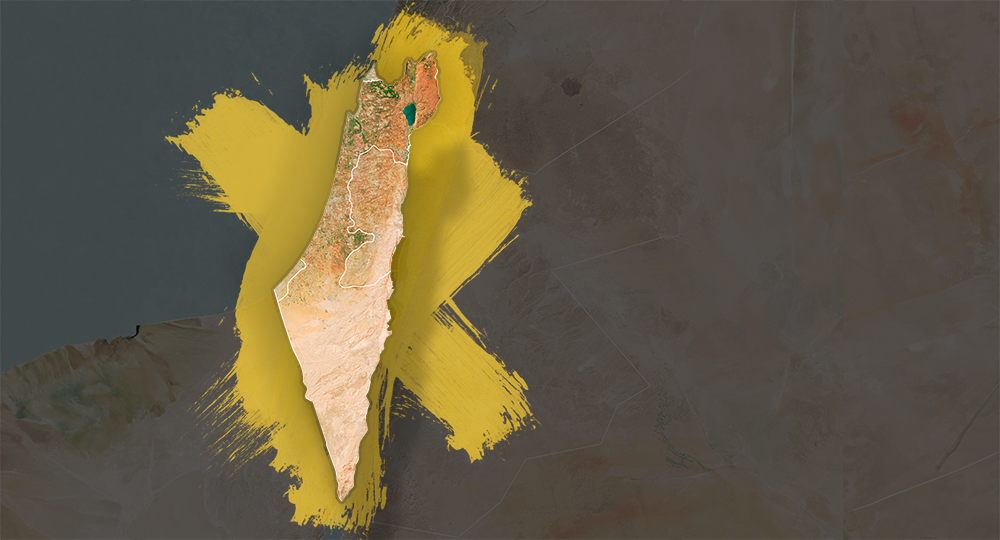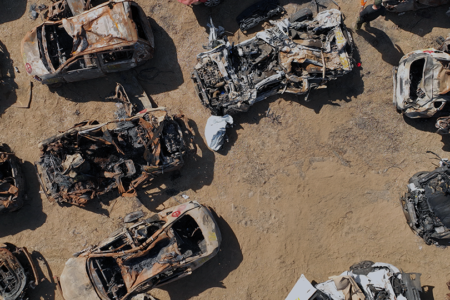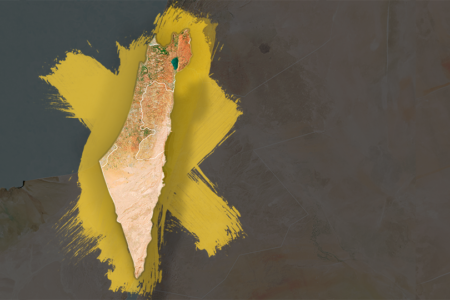Bordering on Normal
Why Israel’s boundaries have yet to be sealed
Israel is bordered by Lebanon and Syria in the north, Jordan in the east, the Mediterranean Sea in the west, and Egypt in the south. No map, however, conveys the unsettled nature of these borders.
The country’s frontiers have been in flux since Britain’s 1917 Balfour Declaration and the ensuing San Remo Conference (1920) that assigned the Palestine Mandate to Britain. Both envisioned the Jewish national homeland as encompassing today’s Israel, the West Bank, Gaza, and Jordan. But in 1922, the British lopped off the territory east of the Jordan River to create Transjordan.
On November 9, 1947, the UN General Assembly partitioned western Palestine into Jewish and Arab states, charting the borders of each. The Arabs rejected outright a Jewish state, waging war to crush it immediately after the new state declared its independence on May 14, 1948.
Israel’s position was that the war’s outcome—not the Partition Plan—would define its boundaries. However, wrote historian Tom Segev in his book 1949: The First Israelis, U.S. President Harry Truman insisted Israel pull back on all fronts to the partition lines.
The Palestinians have persistently fought against Israel. As they claim in the 1988 Hamas Covenant (Article 11) and the Palestine Liberation Organization (PLO) Charter (Article 2), the land between the Mediterranean and the River Jordan belongs solely to them and the Muslim world. The Arab states have taken a more nuanced position.
Egypt
As Arab-Israel hostilities waned at the end of 1948, UN mediator Ralph Bunche facilitated talks on the Greek island of Rhodes, resulting in an armistice line between Egypt and Israel. The fighting ended on January 7, 1949. Truce talks began five days later.
Egyptian King Farouk’s delegation agreed on an “armistice demarcation line” based on the military situation on the ground on February 24, 1949. Cairo insisted this Green Line not be construed as a political boundary, recalled Walter Eytan in his book The First Ten Years: A Diplomatic History of Israel.
Farouk was deposed on July 23, 1952, in a coup led by Gamal Abdel Nasser. Around 1955, Egypt’s military decided to make Gaza (which it occupied provisionally) a base for “state-organized Fedayeen” raids, according to historian Benny Morris. Nasser declared, “There will be no peace on Israel’s border. . . . We demand . . . Israel’s death.”
Fedayeen attacks and Israel Defense Forces (IDF) retaliations culminated in the 1956 Sinai Campaign in which Israel captured Gaza and the Sinai. U.S. President Dwight Eisenhower pressured Israel to withdraw in 1957.
Israel captured Sinai and Gaza again in the 1967 Six-Day War. The 1973 Yom Kippur War did not much change the map—although, in 1974, the IDF partially pulled back in Sinai.
In November 1977, Egyptian President Anwar Sadat ended the state of war by visiting Israel. The 1979 Egypt-Israel Peace Treaty established an internationally recognized border along the 128-mile-long Negev-Sinai line. In April 1982, Israel completed its withdrawal from Sinai. Successive Egyptian governments have honored the pact, though infiltrations are a recurring problem.
Gaza
The Israel-Gaza border has long been a powder keg, save from June 1967 when Israel recaptured Gaza until Israel and the PLO signed the Oslo Accords in September 1993. A 1994 annex set the Israel-Gaza boundary. Gaza has a separate border with Egypt.
PLO leader Yasser Arafat arrived in Gaza in July 1994. In October 2001, early in the Arafat-initiated Second Intifada, Palestinians launched rockets at Jewish settlements inside the Gaza Strip. In September 2005, as the intifada faded, Israel disengaged from Gaza, dismantling settlements and pulling out the IDF.
In 2006, Hamas won the Palestinian elections and, by June 2007, had banished the PLO from the Strip. Hamas has since instigated wars and frequent rounds of
lower-level fighting. While seeking to keep war material from reaching Hamas, Israel supplies Gaza and its 2 million denizens with fuel and allows produce, medicine, and manufactured goods to traverse the border.
Some 150,000 Gazans worked inside Israel prior to October 7, 2023, when Hamas overran the border in a massive attack on the Jewish state, brutally slaughtering more than 1,200 innocent Israelis, including infants and children, and kidnapping more than 240 civilians.
Jordan
King Abdullah’s delegation went to Rhodes in 1949 for show. In secret, the monarch was personally negotiating with Israel in one of his palaces. After each round of talks, under darkness, the Israeli delegation crossed back into western Jerusalem. On April 3, 1949, Abdullah’s delegation in Rhodes signed the deal he had reached with Israel. The monarch saw the truce as a stepping stone to a possible peace.
Jordan annexed the West Bank in December 1949, incensing the Palestinians. On July 20, 1951, while King Abdullah was heading to pray at Jerusalem’s al-Aqsa Mosque, the Palestinian former Mufti Amin al-Husseini had him assassinated.
In 1953, Abdullah’s son Hussein became king. The Green Line of 1949 became the de facto boundary. Reneging on Jordan’s commitments, Hussein prevented Israelis from reaching the Old City and Hadassah Hospital, the National Library, and Hebrew University, all on Mount Scopus. Jordan refused Christian pilgrims entry to the Old City via the Mandelbaum Gate checkpoint if their passports were stamped by Israeli border authorities.
Jordan lost the West Bank and Jerusalem to Israel in 1967. Bowing to pressure in 1988, Hussein turned over responsibility for the West Bank to the PLO. And in October 1994, Prime Minister Yitzhak Rabin and Hussein signed a peace treaty giving Israel an internationally recognized border with Jordan. A treaty annex asserted that Amman does not recognize Israel’s control of the West Bank.
West Bank
This is biblical Judea and Samaria. Israel has tried to erase the Green Line here since taking the area in 1967. As part of the 1993 Oslo Accords, the IDF withdrew from Palestinian cities, handing them to the Palestinian Authority.
Some 3 million Arabs live in the territory. In 1997, Israel pulled out of Hebron save for enclaves near the Cave of the Patriarchs.
In 2002, during the Second Intifada, Israeli official Ariel Sharon ordered the construction of a security fence along parts of the Green Line to deter terrorists.
Jerusalem
The UN Partition Plan called for the city’s internationalization. But after the 1948–49 war, eastern Jerusalem and its Old City fell to Jordan.
Israel declared western Jerusalem its capital in December 1949. After the 1967 Six-Day War, Israel extended its sovereignty over the unified city and incorporated Arab neighborhoods, enfolding them into the municipality’s boundaries. During the Second Intifada, construction (still unfinished) began on a barrier sealing off greater Jerusalem from the West Bank.
On July 30, 1980, Israel’s Knesset declared united Jerusalem as Israel’s capital. U.S. President Donald Trump’s administration recognized Jerusalem as Israel’s capital in 2017. Israel never annexed Jerusalem; its Arab residents (40 percent of the population) are not Israeli citizens.
Lebanon
In 1949, neither Lebanese President Bechara al-Khoury nor Prime Minister Riad Bey el Solh seemed interested in prolonging the conflict with Israel. Christians were then a plurality of Lebanon’s population (at least on paper).
Armistice talks were held at Rosh Hanikra and signed on March 23, 1949. Israel returned to the international border, which remained quiet until PLO forces moved from Jordan to southern Lebanon in 1970. Israel ousted them in the 1982 War. Iran’s infiltration of Lebanon’s Shi’ite Arabs compelled Israel to retain a buffer zone until May 2000. A “blue line” drawn by the UN separates the countries.
Hezbollah, Iran’s proxy, has instigated repeated rounds of fighting. It claims territory for Lebanon on the formerly Syrian, now Israeli, Golan Heights. In October 2022, under Israeli Prime Minister Yair Lapid, Jerusalem and Beirut agreed (with Hezbollah’s nod) on a maritime border, enabling oil exploration by both countries.
Syria
In 1949, Syrian General Husni Zaim took charge of the country after a bloodless coup. Syria had captured territory on the Israeli side of the international boundary. Notwithstanding public bellicosity, Zaim sent word to Prime Minister David Ben-Gurion that he sought a clandestine meeting to discuss peace and resettling 350,000 Palestinian refugees in Syria in return for border adjustments.
Ben-Gurion would not meet Zaim until he first agreed that the armistice lines run along the international border. After contentious talks in a stifling tent at the foot of the Golan Heights, a deal was reached on March 23, 1949. On August 14, 1949, Zaim was killed in a coup. Damascus insisted that Israeli territory along its border with Syria’s Golan Heights be demilitarized and undeveloped. Syria’s army periodically shot at Israelis draining the Huleh Valley and developing the National Water Carrier.
In 1967, Israel captured the Heights. During its surprise 1973 attack, Syria retook parts of the Golan. In May 1974, an area of separation patrolled by the UN was created, with Israel ceding the town of Kuneitra. On December 14, 1981, the Knesset annexed the Golan; in 2019, the Trump Administration recognized the annexation.
Egypt, Jordan, and Lebanon (before Hezbollah’s ascendancy) took a realpolitik approach to Israel’s existence and were willing to talk about boundaries. For the Palestinians, the issue isn’t borders; it’s Israel’s very existence. Syria takes its cue from them and Iran. So, Israel will not enjoy recognized borders until the Palestinians have a change of heart.
Photo: Adobe Stock







